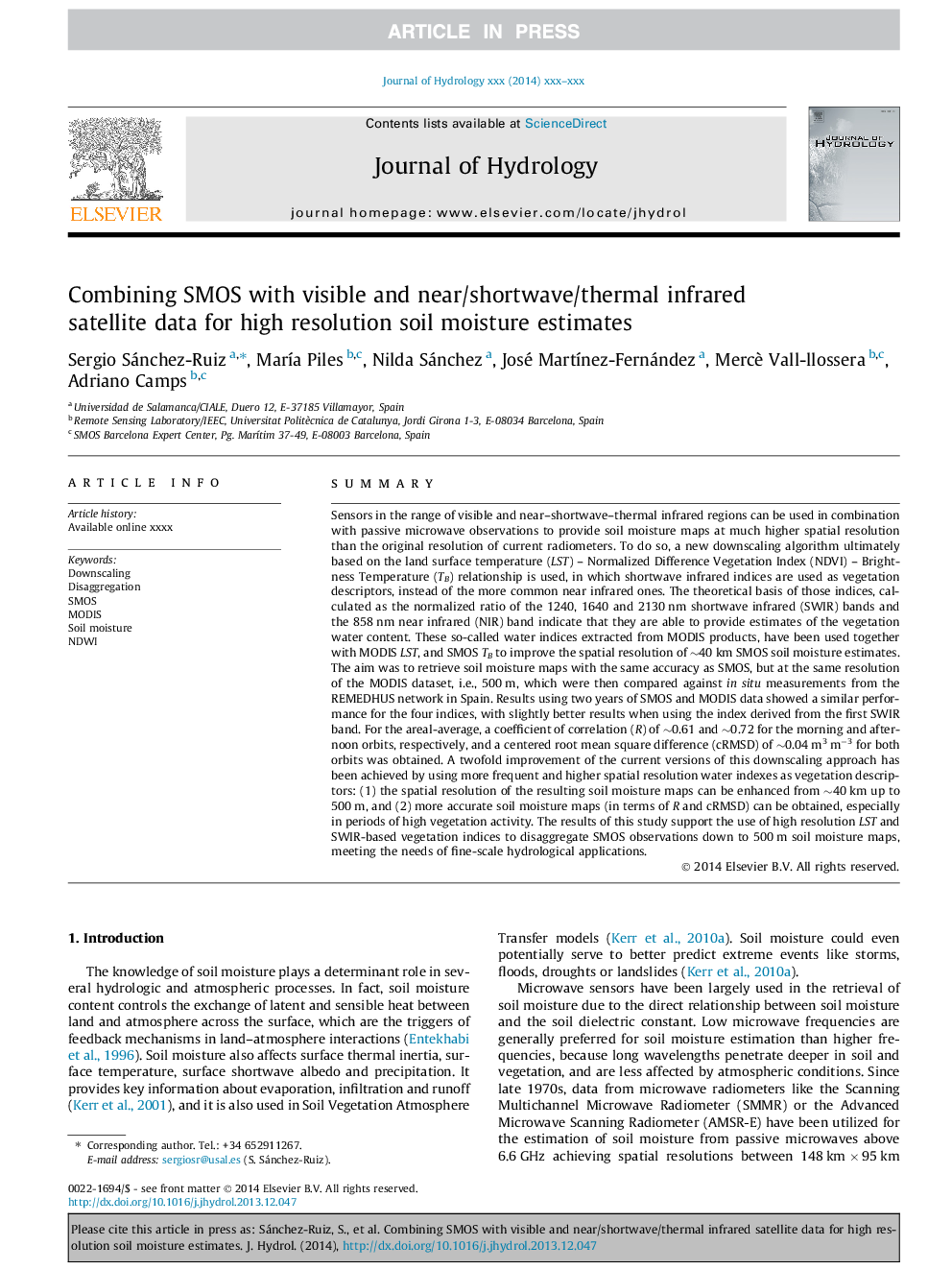| کد مقاله | کد نشریه | سال انتشار | مقاله انگلیسی | نسخه تمام متن |
|---|---|---|---|---|
| 6412688 | 1629932 | 2014 | 11 صفحه PDF | دانلود رایگان |
عنوان انگلیسی مقاله ISI
Combining SMOS with visible and near/shortwave/thermal infrared satellite data for high resolution soil moisture estimates
دانلود مقاله + سفارش ترجمه
دانلود مقاله ISI انگلیسی
رایگان برای ایرانیان
کلمات کلیدی
موضوعات مرتبط
مهندسی و علوم پایه
علوم زمین و سیارات
فرآیندهای سطح زمین
پیش نمایش صفحه اول مقاله

چکیده انگلیسی
Sensors in the range of visible and near-shortwave-thermal infrared regions can be used in combination with passive microwave observations to provide soil moisture maps at much higher spatial resolution than the original resolution of current radiometers. To do so, a new downscaling algorithm ultimately based on the land surface temperature (LST) - Normalized Difference Vegetation Index (NDVI) - Brightness Temperature (TB) relationship is used, in which shortwave infrared indices are used as vegetation descriptors, instead of the more common near infrared ones. The theoretical basis of those indices, calculated as the normalized ratio of the 1240, 1640 and 2130Â nm shortwave infrared (SWIR) bands and the 858Â nm near infrared (NIR) band indicate that they are able to provide estimates of the vegetation water content. These so-called water indices extracted from MODIS products, have been used together with MODIS LST, and SMOS TB to improve the spatial resolution of â¼40Â km SMOS soil moisture estimates. The aim was to retrieve soil moisture maps with the same accuracy as SMOS, but at the same resolution of the MODIS dataset, i.e., 500Â m, which were then compared against in situ measurements from the REMEDHUS network in Spain. Results using two years of SMOS and MODIS data showed a similar performance for the four indices, with slightly better results when using the index derived from the first SWIR band. For the areal-average, a coefficient of correlation (R) of â¼0.61 and â¼0.72 for the morning and afternoon orbits, respectively, and a centered root mean square difference (cRMSD) of â¼0.04Â m3Â mâ3 for both orbits was obtained. A twofold improvement of the current versions of this downscaling approach has been achieved by using more frequent and higher spatial resolution water indexes as vegetation descriptors: (1) the spatial resolution of the resulting soil moisture maps can be enhanced from â¼40Â km up to 500Â m, and (2) more accurate soil moisture maps (in terms of R and cRMSD) can be obtained, especially in periods of high vegetation activity. The results of this study support the use of high resolution LST and SWIR-based vegetation indices to disaggregate SMOS observations down to 500Â m soil moisture maps, meeting the needs of fine-scale hydrological applications.
ناشر
Database: Elsevier - ScienceDirect (ساینس دایرکت)
Journal: Journal of Hydrology - Volume 516, 4 August 2014, Pages 273-283
Journal: Journal of Hydrology - Volume 516, 4 August 2014, Pages 273-283
نویسندگان
Sergio Sánchez-Ruiz, MarÃa Piles, Nilda Sánchez, José MartÃnez-Fernández, Mercè Vall-llossera, Adriano Camps,